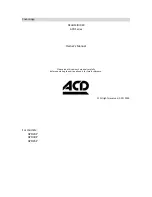
5IFBNPVOUPGEFIVNJEJGZJOH
CFDPNFTMFTTJOXJOUFS
When the temperature and humidity are low, the
amount of water collected is decreased.
In winter, because the temperature is lower than in summer,
the effect of the dehumidifier is greatly reduced as shown in
the graph below.
Although only a little water collects in the tank, this is
not a malfunction.
3PPNUFNQFSBUVSFNBZSJTF$EVSJOHPQFSBUJPO
The dehumidifier does not have a cooler function. Due to heat produced during operation, the room temperature may rise
2-4°C. As a result, the unit may blow warm air, but this is not due to a malfunction. (During winter, the air may not feel warm
as the temperature is below body temperature.)
5IFVOJUDBOPQFSBUFJOBSPPN
UFNQFSBUVSFSBOHFPG$
If the room temperature exceeds 35°C, the unit may
operate in blower mode or increase the airflow. This is
because the temperature within the unit rises causing
the protection mechanism to operate.
If the temperature becomes lower than 7°C,
blowing operation starts to prevent freezing of
dehumidified water.
5IFIVNJEJUZSFBEJOHPOUIFVOJU
NBZEJGGFSGSPNBIZHSPNFUFSJO
UIFTBNFSPPN
Even in the same room, temperature and humidity
levels may differ from place to place. If the hygrometer
and the unit are in different parts of the room, the
humidity levels are prone to differ.
Moreover, humidity levels differ between places that
have good and no airflow.
Use the reading on the unit as an estimate.
&
#FGPSFVTJOHUIFVOJU
What You Need To Know
)PXEPFTUIFEFIVNJEJàFSXPSL
If you pour cold water into a cup, the air around it becomes
cold, causing water droplets to form on the surface of the
cup.
The dehumidifier takes advantage of this phenomenon to
remove moisture from the air.
1
The unit draws air from the room, cools it with its cooling
coil, causing the moisture to transform into water
droplets.
2
The water droplets fall into the water tank.
3
%FIVNJEJàFEBJSJTIFBUFECZUIFSFIFBUJOHDPJMBOE
UIFOCMPXOPVU
The humidity of the room is thus reduced by repeating
steps
1
,
2
, and
3
.
①
②
③
%SZ 8BSNBJS
$PPMJOHDPJM
.PJTUBJS
$PNQSFTTPS
3FIFBUJOHDPJM
8BUFSUBOL
$BVTF
Inconsistencies
in temperature
and humidity
Difference in
location
Difference in
hygrometer
precision
4VNNFS IVNJEJUZ
8JOUFS EBNQOFTT
0
2
4
6
8
10
12
14
5
10
15
20
25
30
The values shown on the graph were measured
at constant temperature and humidity and do not
reflect values obtained in actual usage conditions.
%FIVNJEJGZJOHDBQBDJUZ -EBZ
3PPNUFNQFSBUVSF $
Value for HIGH when humidity is 80%
W
hy
ar
e they different?








































